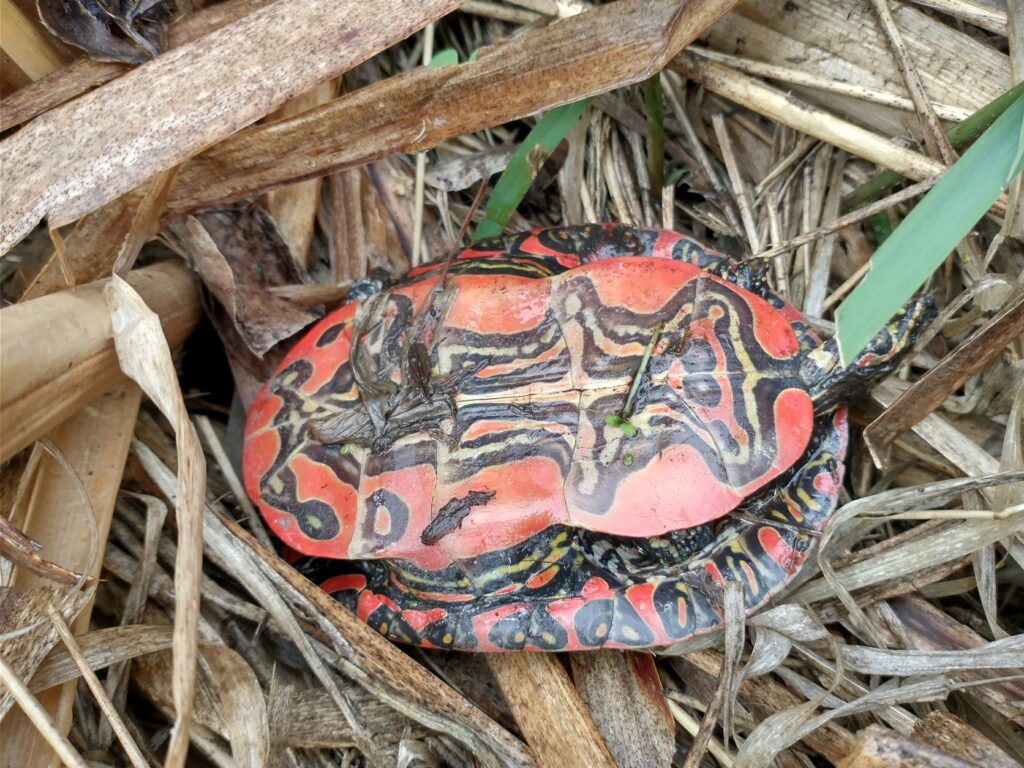Driving by a pond on a wooded road one day I spotted a few odd shaped rocks slowly sliding along the black top. Those rocks turned out to be painted turtles are on the move. Having seen the aftermath of too many vehicle collisions with these vibrant turtles, I stopped short and put on my hazard lights.
Checking for oncoming traffic, I jumped out of my truck and picked the first one up. Instinctively I knew to hold it at arms lengths just like it knew to start peeing, releasing a huge stream for such a small animal. I quickly gathered up the others, each one contributing to a stream of predator deterrent on the warm pavement.
Painted turtles, chrysemys picta, get both their common and scientific names from the bright yellow and red stripes on their head, legs, and tail and the similar colors found on the underside of their shells. These are the most wide-ranging turtles of North America and can be found from coast to coast from southern Canada to northern Mexico.
Like their slow gate, painted turtles preferred habitat is in slow water, particularly ponds and lakes. These habitats are known as lacustrine ecosystems and refer to their characteristic still water.
The depth and size are what separate a pond from a lake. And depth and size can have a big impact on the aquatic environment of these water bodies. A pond with shallower water has sunlight that penetrates to the bottom, allowing rooted aquatic plants to grow throughout.

The water is also a more consistent temperature no matter the depth. A lake on the other hand only has aquatic vegetation around it edges and has a stratified water column with layers of warm water on top and colder water with depth.
Water temperatures in lakes are usually only subject to the changes in the seasons. Where as the water temperature in ponds is more subject to change from variations with wind, precipitation, evaporation, as well as the changing seasons, making a fluctuating habitat for aquatic species.
Lacustrine systems are broken down into three habitat zones. Bottom-dwelling animals use the littoral zone of shallow water where light penetrates to the bottom and rooted plants. The limnetic zone is the area of open water where light can penetrate and support animal and plant planktons. And the profundal zone is the area below where light can penetrate.
Painted turtles spend most of their time in the littoral zone where old turtles can snack on aquatic vegetation and younger turtles can find tad poles, snail, and crayfish. When not feeding they spend the bulk of their time basking on docks, rocks, and down trees near the shore where they can easily slip into the water to evade predation.
In some cases when these turtles mate in fall, the females are able to delay fertilization till spring. In spring and early summer, females will dig holes in the sand to lay a clutch of 2-20 round white eggs that will hatch in the fall.
Unfortunately, I know my “rescue” efforts are probably short lived and those turtles will be back, crossing that same road again soon. Beside predation, the main threats to these turtles is vehicle collisions, especially when females are moving back and forth from their nest.
The next time you are driving by those lacustrine lake and pond habitats, keep an eye out for turtles basking in the sun and, more importantly, for any slow-moving rocks crossing the road.
When Adam isn’t rescuing turtles off of roads or working as a field biologist, he is likely on some hiking, biking, or skiing adventure somewhere in the Northwest. He wrote about red band trout in the May-June 2021 issue of Out There.













